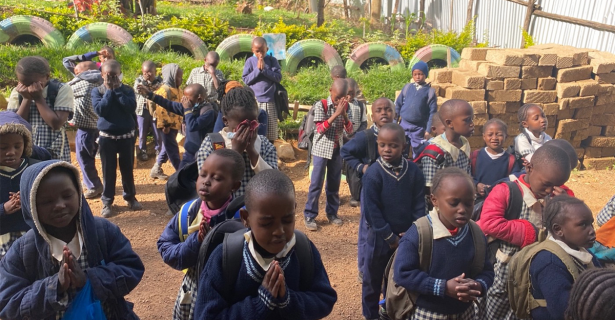I wish I could say I am a stranger to Kenya. I wish I could describe the country with the awed language of a tourist. But mine is an even better perspective: one of a local boy and seasoned teenager who is a returning sojourner. Maua in Eastern Kenya’s Meru County is a small developing town hidden in Nyambene ridges of Mt Kenya’s slopes. Returning after almost a year at Tufts in the US carries expectations and a newfound sense of responsibility. A responsibility whose weight I had not felt until I saw the eager faces of kids I used to tutor singing songs to welcome me back. I was surprised with my emotions, partly because I did not expect to feel such a longing for their chorus and excitement. I am glad I came back.
The Cornerstone education program has been serving the Maua community for the last four years. We started as an after-school program to assist students with homework after school. We borrowed community centers such as church halls and unused classrooms from other schools. With time, we felt the need to have our own place. This is where Cornerstone Education Centre was born. Our tutoring program at Cornerstone has been going strong, with six new additional tutors and twenty-three more pupils this year. Our after-school program took a pause when the pandemic hit. Due to all the challenges that come with having a completely offline curriculum, the students stayed home for nine months without any instruction from teachers. Filling this gap and convincing parents to allow their kids to attend the program has been the main challenge this year. Turnout has been low since the government instituted a curfew to curb the COVID rates in the country. The need to get home in time for the curfew has forced the pupils to stay home, but we’re hoping the new computer literacy center will help change that.
My second week in Maua was spent getting to know the new tutors and the various classes they taught. So many changes had happened in my absence: the education system had changed while I was gone, no more holidays for the children, COVID rules, the list is endless. I had read about how the changes would affect our program and worked to adapt to fit the new regulations, but the shock of it all had not hit me until I saw the school. I could see some familiar faces, the school cook, custodian, as well as children I had driven to school years earlier. While it felt like everything about the system and the children had changed, most of it had also remained peculiarly the same. I saw the school through the lens of someone that had seen a new world. I desperately wanted to change it.
I arrived just one day before the midterm break started, so we bid the children farewell for ten days, after which we would begin the national examinations for PP2 on the first week of June. The annual national assessment tests are taken by pupils in PP2 who to join primary school. My first week working with some of the teachers was challenging. We still did not know each other, and most of them did not understand my role at the school. Most of them are still puzzled by how their manager can be someone so much younger than them. The first week after the break had much activity. The most noteworthy was a visit from the County Director of Education, who ensures COVID regulations are followed. He was thoroughly impressed with the construction of a new class and all the measures we had put in place. So far, my biggest challenge has been getting a grasp on all the records of the last nine months, both financial and academic. The program’s records are on a dusty shelf, stored in a very haphazard manner, which prompted my desire for a more streamlined and easily accessible system. This revelation is perhaps what has inspired the idea of a computer hub at the school. We decided to prepare four desktops and a laptop for demonstrations for the children to learn with and acquaint themselves with technology. No one was more excited about the initiative than the children, who named the new center Mwangaza (light).

